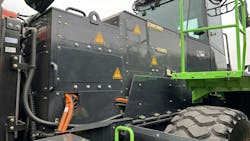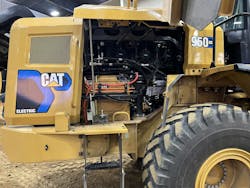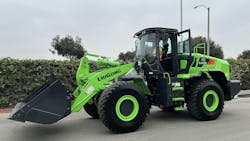After seeing years of marketing hype and enduring trade show prototype fatigue, there are now some battery-electric earthmovers charging piles and digging holes for real owners.
Many are in the highly regulated state of California where incentives continue to be offered, but it’s a start.
The activity is noteworthy because EV pickup and car manufacturers are pulling back right now due to sales softening after the $7,500 federal tax credit reached the end of its life.
Ford CEO Jim Farley told The Wall Street Journal that EV market share may fall by more than half, to between 4% and 5% of total sales before 2025 is in the books. This despite the final month of the tax credit (September) pushing EVs to 12.2% of vehicle retail sales for that month.
Our sister publication Fleet Maintenance has reported that Ram parent Stellantis said it is discontinuing development of the full-size all-electric Ram 1500, as “demand for full-size battery-electric trucks slows in North America,” the company said in a release.
The EV pickup category overall has seen pullbacks and adjustments due to an overall decline in demand, as well. In addition, price plays a part, as Stellantis and other producers are downsizing models to include a lower price point.
Earthmover action
Electric earthmover production hasn’t come close to pickups, as battery size and weight has been an issue in the quest to move up from easier-to-electrify mini excavators into larger, higher-production types of equipment.
Also, some users are still skeptical about charging options for out-of-the-way job sites, and those who work on 24/7 jobs find shutting a piece of iron down for charging to be inconvenient, to say the least.
Volvo Construction Equipment and Case are further along than other OEMs in North America, as they have multiple battery-electric products available for purchase now.
Others earthmoving manufacturers seem to have the odd mini excavator and dumper or two, and of course, prototypes under test.
So many prototypes: "When is it going to be for sale?"
"We don't know" is often the answer.
Then there are the diesel electric-drive/energy-collecting combinations led in several machine categories by Caterpillar and John Deere. Komatsu is also active.
Caterpillar doesn’t have a piece of battery-electric equipment past the field follow (customer testing and feedback) stage. It has shown the media prototype wheel loaders and chargers and seems close.
John Deere has focused more on incorporating electric drive componentry so far than on entire battery-electric units; however, acquisitions of battery technology and related companies such as Kreisel mean there is more to come.
It will be interesting to watch for any battery-electric introduction announcements at Conexpo.
Electric backhoe on contractor duty
Steve Lovett is the owner and president at Lovett Excavating in Twain Harte, California.
Lovett is engaged in all manner of infrastructure work, including sewer and water, homebuilding, and paving. He has a fleet of 25 different units, including excavators, dozers, loaders, haul trucks, and compactors.
"It's a little bit of everything, Lovett says. "We do roads, pavements, culverts, and right now we're doing a 300-lot subdivision. We'll be starting a 900-acre one this spring."
Lovett Excavating has two Case 580EV backhoe loaders he's been using for about a year.
"My equipment company, Sequoia Equipment out of Fresno, and Dennis Monahan, had called me and told me about these, so it kind of piqued my interest," Lovett says. "I mean, everything was starting to go electric there for a while, so I wanted to see what they were about."
He had also seen the 580EV at Conexpo 2023, but now he could move dirt.
How did Case test the 580EV?
"I just went down to the yard at Sequoia Equipment in Fresno and drove it around their yard, dug with it a little bit," Lovett says. "I was impressed with the breakout power it had. It's a lot stronger than a diesel-powered tractor is.
"They [electrics] just don't last as long; the diesel, when you fill it up, you keep going," Lovett said. "The electric, you've got to charge up for a little while."
That said, Lovett is not worried about charging. Case supplied him with two chargers, one for his yard and a portable one to bring to jobs. He does watch runtime closely.
"If you're working it really hard, you're only going to get four to five hours out of it," Lovett says. "If you're working it hard and roading it a lot, too. Roading it seems to eat the batteries up a lot more."
Lovett says there are features on his electric backhoe that a standard unit doesn't have.
"I like the variable control on the hydraulics. You can go fast, medium, and slow where it gets strong, like if you're digging in rocks," he says. "You want it slow in rocks to use all the power."
Lovett also appreciates the warning in the cab before the battery power goes too low. "You have the meters right there that tell you what percentage you're at. It's kind of impressive," he says.
Lovett primarily uses the backhoes for trenches and backfilling.
"We're doing the sewer, the water, propane, electric, a little bit of everything, Lovett says. "So it's a very, very dependable unit, very strong. Like I said, the breakout power amazed me."
He is happy with the loader end, too, when he has a occasion to load his five-yard truck. "The loader is very responsive and you can also adjust your hydraulics for speed," Lovett says.
The company has not yet tried more than a thumb on the backoe end, but Lovett sees a day when he may add breakers.
"I kind of wanted to run them just as a whole alone first to to familiarize myself with them, to see if that's going to work out for our company or not," he says. "And it seems that they are, so yeah, I probably will go with the breaker."
All of his operators are at the point where they've run both the diesel and electric backhoes in the fleet.
"[They've said] that the electric one is a lot stronger, has better breakout power, and the lifting capacity is better," Lovett says. "Everyone who's run the electric ones really love them. My son, who's also an operator for me, really likes the electric compared to the [diesel] Super L."
Lovett's only concern is battery life, in that he'd like to see better, longer-lasting technology for batteries.
"I'm not sure how long these batteries are going to last before we've got to replace them," Lovett says.
Case says the longevity of lithium-ion batteries is measured in terms of battery cycles—the number of times a battery is depleted and charged. On the 580EV, the battery rating is designed around the average diesel machine life of over 10 years.
The company also notes that when the battery reaches its rated number of cycles, it doesn’t just stop working. The battery rating corresponds to its capacity to store energy. At the 10-year point, the battery may still be functional, but it could have less run time that it had when it was brand new.
It's another way of saying it depends on the workloads and applications.
Loaders on municipal duty
Former AEMP/Construction Equipment Fleet Masters and Under 40 in Construction Equipment award winner David Bolderoff, CEM, was an early adopter of electric equipment in his quest for sustainability for the Los Angeles County Sanitation Districts (LACSD).
After working with alternative fuels and electric on the on-road side of his fleet, Bolderoff, manager of the Districts' fleet management and transportation section, turned his attention to off-road electric equipment a number of years ago. His research led him to try wheel loaders.
About the Author
Frank Raczon
Raczon’s writing career spans nearly 25 years, including magazine publishing and public relations work with some of the industry’s major equipment manufacturers. He has won numerous awards in his career, including nods from the Construction Writers Association, the Association of Equipment Manufacturers, and BtoB magazine. He is responsible for the magazine's Buying Files.




